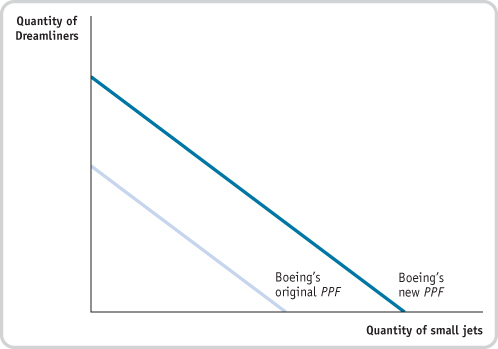Question 2.1
1. True or false? Explain your answer.
An increase in the amount of resources available to Boeing for use in producing Dreamliners and small jets does not change its production possibility frontier.
False. An increase in the resources available to Boeing for use in producing Dreamliners and small jets changes the production possibility frontier by shifting it outward. This is because Boeing can now produce more small jets and Dreamliners than before. In the accompanying figure, the line labeled “Boeing’s original PPF” represents Boeing’s original production possibility frontier, and the line labeled “Boeing’s new PPF” represents the new production possibility frontier that results from an increase in resources available to Boeing.

A technological change that allows Boeing to build more small jets for any amount of Dreamliners built results in a change in its production possibility frontier.
True. A technological change that allows Boeing to build more small jets for any amount of Dreamliners built results in a change in its production possibility frontier. This is illustrated in the accompanying figure: the new production possibility frontier is represented by the line labeled “Boeing’s new PPF,” and the original production frontier is represented by the line labeled “Boeing’s original PPF.” Since the maximum quantity of Dreamliners that Boeing can build is the same as before, the new production possibility frontier intersects the vertical axis at the same point as the original frontier. But since the maximum possible quantity of small jets is now greater than before, the new frontier intersects the horizontal axis to the right of the original frontier.

The production possibility frontier is useful because it illustrates how much of one good an economy must give up to get more of another good regardless of whether resources are being used efficiently.
False. The production possibility frontier illustrates how much of one good an economy must give up to get more of another good only when resources are used efficiently in production. If an economy is producing inefficiently—that is, inside the frontier—then it does not have to give up a unit of one good in order to get another unit of the other good. Instead, by becoming more efficient in production, this economy can have more of both goods.